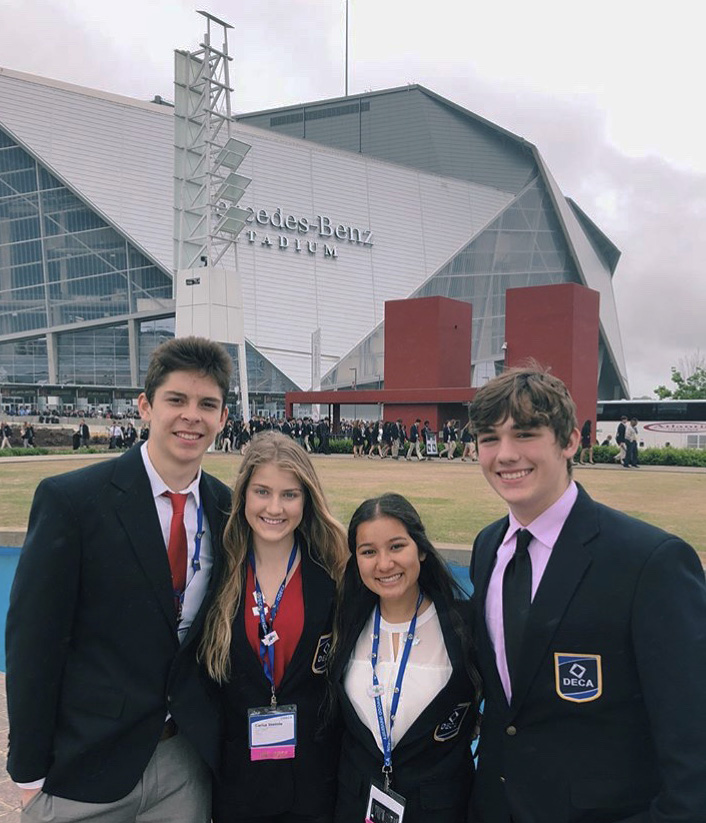Las Vegas.
Orlando.
Virginia Tech.
Sandy Hook Elementary School.
These names, forever ingrained in America’s memory, represent the deadliest mass shootings in recent U.S. history. And names like these are appearing in the news more and more frequently. According to Gun Violence Archive, there have been 291 mass shootings in the U.S. in 2017 alone, resulting in 363 deaths.
How has the nation responded to the rise in mass shootings and how has Pierce County worked to prevent such tragedies?
“High schools and the public school system [are not the only ones training for the eventuality of an active shooter]. Colleges and businesses are doing active shooter trainings now, because it could happen at any time, in any situation,” counselor Michael Sanchez said. “Every year [the protocols] are changing. We train, we revise and we train again. The more trained we are the more… natural and organic [it is] for us to address a real threat.”
As gun violence increases nationwide, preventative measures against mass shootings take top priority, according to School Resource Officer Ketter.
“Here in Pierce County we have been making changes for years. Puyallup and Pierce County are so far ahead of other places, not only in the state but around the country, that we started a new national trend…what we are doing in the schools won a national award a couple of years ago because of how far ahead we are. Two summers ago I was flown down to florida to speak at the national homeland security conference and talk about what we are doing in Puyallup and further in the Pierce County schools,” Ketter said.
The key to the innovative techniques in Pierce County is expedited communication, Ketter says.
“We have branched out in pretty much every direction we can to help…We reached out to make sure that every one of our partners is getting the same training we do in order to better our common goal rather than just being reactive to it, because we know it is so much bigger than just the police department,” Ketter said.
One of the most revolutionary aspects of new trainings centered around how the fire and police departments interact.
“Usually fire departments will stage until the police department says it is safe and then they come in. The problem we ran into with that was that before the police department can secure a scene the fire department cannot get in and tend to those who are injured. The longer that takes, sometimes people do not make it, so Central Pierce Fire now goes to active shooter training with us,” Ketter said. “They have gotten all-new bulletproof vests and tactical gear, they actually go in with us now, they do not wait anymore.”
According to Ketter, the benefits of the new joint trainings do come with added risk on the part of the fire department.
“From a fire department standpoint, they are putting a lot of faith in us. You have a group of firefighters who are basically unarmed, going into a place where there is a threat, hoping that we take care of it. So for them that is a huge, huge step that they take and all the respect in the world to [the fire department] for doing that,” Ketter said. “But now they are treating patients in minutes, where it could have taken hours. For them to get in that much sooner and to provide life-saving treatment, they are saving more lives than they could before.”
Just as the fire department has adapted their protocol for active shooter situations, so has the police department.
“It used to be that police would secure the area and then fire department would come in and provide their medical. Now the fire department has given the police department a ton of training. [The police force] participates in TCCC [Tactical Combat Casualty Care] training which is basically emergency first aid training,” Ketter said. “We carry ‘go bags’ now, which usually the fire department carries. They are basically full of emergency medical supplies. We no longer just stand there and watch the fire department as they are trying to do something, we can get in there and start doing treatment with them. The more that I can do to help the fire department, the more lives we can save.”
These integrated trainings and shared skills have combined the police and fire departments into a single response unit, Ketter says.
“In addition to working with the fire departments now almost yearly, if not more often than that, we are training directly with the fire department. We now move as a group, so that they understand our movements better and we also understand their movements better,” Ketter said. “Police and fire are very different when it comes to how we respond, and now we are training together more so we have become way more familiar with each other, which helps. We have become a police-and-fire blend with an overlap of responsibilities.”
Schools have also been integrated into the response network, Ketter says.
“We are also bringing that training into the schools for the staff..the police department, the fire department, and the school district are all training together now to become one big emergency response unit. The faster we can get help and the more people are working together, the more lives we can save,” Ketter said.
The benefit of the schools’ integrated training is standardization of training, procedures and response, which expedites response and eliminates the risk of miscommunication, according to Ketter.
“All schools in Pierce County now have the same lockdown procedures, so if I show up at a school that might not even be in Puyallup, they know what to expect of me, I know what to expect of them. This takes out all of the communication in the beginning so that we can just go in and do what we need to do to secure the school,” Ketter said.
According to School Security Officer Jim Jenkins, school resource officers provide the key communication link between the police department and schools in providing added security.
“School resource officers are the bridge between the police and the schools. They do threat assessments, make sure more doors are locked and ensure that response is faster,” Jenkins said.
Ketter outlines how school resource officers work with schools to ensure safety.
“We have been doing a lot of what is called crime prevention through environmental design. There are what are called ‘soft targets,’ which is basically easier places for people to come and do bad things. Schools are one of those places, so we have been going around and trying to think how we can make our school safer,” Ketter said. “That is everything from doing lockdown drills to walking around our campus to try to think of how we can make our campus more secure but at the same time not make it into a prison.”
In addition to reinventing prevention efforts, the Puyallup School District has adopted new response procedures to drastically alter communication in the eventuality of an active shooter scenario or other emergency.
“The Puyallup School District was the first that I know of who brought in ICS (Incident Command System). Police, fire, other emergency response groups, hospitals, all run on this certain structure and now the school district is also doing that…so now we are all [communicating] on the same level,” Ketter said.
Jenkins explains how ICS has been adapted to work in schools.
“Incident Command System ICS is a way to manage big incidents. It was originally developed by the forest service for wildfires but now our school has adapted it as a blueprint for if something happens. Typically in ICS someone will say ‘I am in command’ as soon as they realize what is going on. That person will be the incident commander,” Jenkins said. “Incident commander will usually be Mr. Sunich, if he is in the right place when something happens. Incident commander keeps everybody in communication. There will also be an operational commander, who is in charge of directing people.”
The administrators are not the only staff members involved in ICS, Sanchez says. In the event of an emergency, staff members with a class take charge of their students while any staff members not in charge of a class would jump on board.
“A staff member is generally responsible for their classroom at that moment. Administrators are coordinators and [the counselors] are secondary support. If all the administrators are here, then they play a lead role. They have a command station and they take care of everything. If they are unavailable then the counselors step into that leadership role and have to take command of an incident,” Sanchez said.
In addition to the training change of adopting ICS, the school district has used state grant funds to improve technology, according to Jenkins.
“The school district has put a ton of time and effort into upgrading our technology here at school to help emergency responders get in here faster with the mapping that they are doing, with the numbering that they are doing with the buildings, with the camera systems that they are putting in,” Ketter said.
The clearer numbering system and technology is intended to aid first responders who may be unfamiliar with the school when navigating the building, Jenkins explains.
“We also have the room numbers on both sides of the doors now so that police officers and [firefighters] can know where they are. The doors are recessed for fires, so before you could not know where you were and you could not know what was down the hall until you were right on top of the room numbers,” Jenkins said.
Nearly as important to school safety as clearness of communication is quickness of response, Ketter says.
“The faster I can get all the information and get here, the more secure the school is, the better trained the staff and the kids are, the amount of casualties that we may have [will be dramatically reduced],” Ketter said.
However, all the preparation in the world is fruitless without threat awareness. Threat assessment and reporting is a key part of keeping schools–and communities–safe, says Ketter.
“The threat assessments that the school and staff are starting to do with incidents that cause concern are also preventative,” Ketter said.
Sanchez details the procedures in place at PHS for threat assessment and reporting.
“If a red-flag situation pops up in which we need to do a deeper investigation of a student, of a comment, a threat, we have a series of things that we have to do. We do threat analysis of the situation, we pull in a bunch of people to discuss the situation, we bring in a police officer. There are times where we have to involve law enforcement or the district office; we inform them that we have a credible threat but we need more guidance on what to do,” Sanchez said. “There is definitely an increased line of communication between us and law enforcement and all the key stakeholders in those kind of situations: our security personnel here at the school, the district office and then the sheriff’s office.”
According to Sanchez, all the prevention in the world could not eliminate danger completely. However, the precautions already in place do an admirable job.
“I do not think that there is a cut-and-dry [solution to] what a school district should do to avoid an active shooter situation. I think there is a lot that we can do to keep students safe, and we are really good about reporting things that we need to report–to each other, to our community, to our law enforcement–so we react very quickly to any threat, which definitely helps to prevent [active shooter situations.] And we are also really good about screening our students…but I do not think that we could ever be 100 percent safe, unfortunately.” Sanchez said.






